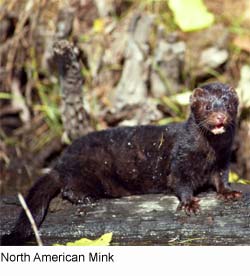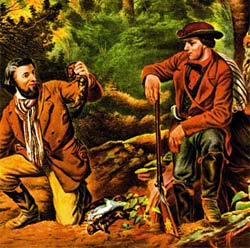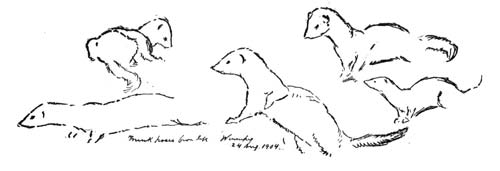|

Swimmers' Bodies: Their long slim body is covered in glossy, thick dark brown or black fur with a white patch under the chin. They have short legs with partially webbed feet, which make them excellent swimmers.

 Just the Facts: The American Mink lives around three years in the wild and 10-12 in captivity and has 4-6 offspring. It is found in places which suit its habits throughout almost all North America, from Florida to the Arctic. An endangered subspecies, the Everglades Mink (Mustela vison evergladensis), is endemic to the Florida Everglades. Just the Facts: The American Mink lives around three years in the wild and 10-12 in captivity and has 4-6 offspring. It is found in places which suit its habits throughout almost all North America, from Florida to the Arctic. An endangered subspecies, the Everglades Mink (Mustela vison evergladensis), is endemic to the Florida Everglades.
The American Mink can be found in wooded areas and fields near streams and lakes. They dig burrows in river banks or take over dens abandoned by other animals.
What's for Dinner? They feed on small mammals, fish, crayfish, frogs and other amphibians, also sometimes eating birds, insects and earthworms. These animals are mainly active at night and do not hibernate. Their predators include coyotes, the Great Horned Owl, red foxes and wolves. They are also trapped for their fur.
How Many Minks? American Mink numbers have been reduced due to loss of habitat and the effects of pollution on their aquatic food supply. They are usually solitary animals. Mating occurs during winter; males and females may have more than one partner. Females give birth to 3 or 4 young during early spring.

Where in the World? The American Mink has found its way into the wild in Europe (including Great Britain) and South America, as escapees from fur farms, and are currently expanding  their range on those continents. In parts of Russia, this species was deliberately introduced to provide quarry for fur trappers. their range on those continents. In parts of Russia, this species was deliberately introduced to provide quarry for fur trappers.
Alien Invasion: Some have established themselves in the wild in Newfoundland, Europe and South America after escaping from fur farms. In Europe, tens of thousand were intentionally introduced by the Soviet Union over a period of several decades, to provide a new game animal for trappers, with disastrous results. In later years, animal rights activists have also released several thousands in their attacks on fur farms.
Mink Management: The larger American male will mate with European mink females earlier in the spring than the males of the same species; the offspring are not born, but the females do not then breed again that season. This has contributed to the decline of the European species. American mink have also been implicated in the decline of the Water vole in the United Kingdom and linked to the decline of water fowl across their range in Europe. They are now considered vermin in much of Europe and are hunted for the purpose of game management.

All text is available under the terms
of the GNU Free Documentation License
|